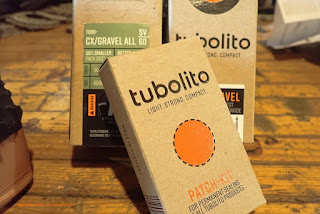 |
| The Tubolito Tubes were run on my Tamland Two. |
This review of the Tubolito Tubes will be my final take on these orange hoops of wonder for the time being. I will have an update here first, then I will close out this series of posts. If you missed my last update, you can reference that here. I'm going to start things off with an update to what I stated in that earlier linked post, so it may be a good idea to check that out first.
The Update: After I posted and related my experience with the S-CX Tubolito, the marketing rep reached out and discussed my problem with me. I ended up getting a replacement Tubolito S-CX because it was thought that I may have received a defective Tubolito. So, I waited until I received that, installed it in the front wheel of the Raleigh Tamland Two, and re-tested that.
Initially I had gone with 40psi, so that's where I started again and the test ride went well. 24 hours later and the tire was not flat! This was definitely better! Now, all along the rear Tubolito has done very well in regard to air retention. Now I would be able to compare the two types of Tubolito tubes without dealing with the defective front that I started out with, which led me to a false conclusion on that Tubolito.
So, it has been a solid week since I have had the new front Tubolito installed and I have ridden the bike a few times. Air retention on the front is as good, if not perhaps a little better than, the rear Tubolito which is the 'heavier-duty' one of the pair. Okay, so I think I've put that issue, and any questions about air retention, to bed now.
Final Words: I think these Tubolito tubes are a definite option for anyone that isn't going to go tubeless for whatever reasons, or that maybe has a bike that isn't going to get used enough to make tubeless worthwhile. This might be a bike you only ride occasionally, or for a short season. Tubes make a lot more sense in these situations. Just air up and go when you want to ride. A tubeless set up will cause issues eventually with dried up sealant, coagulated sealant puddled in one spot of a stationary tire, and cause more headaches with maintaining/correcting issues that arise due to sporadic bike riding and tubeless usage.
Obviously, if you live in an area where punctures are commonplace these might not be the best option. However; if you have a tubeless set up and want a back-up option in case of catastrophic tubeless failure or for a puncture/tear that won't seal? Tubolito tubes could be a very compact, lightweight, reliable option there.
I liked the way that they rode. The interesting thing about this review for me was that I had ridden the front wheel with a typical tube and then with the new Tubolito. I could notice a difference if I focused on it. The Tubolito allowed the front tire to act better over bumpy ground, like a grassy dike I rode during the test. I've no doubt that the rolling resistance is better with Tubolito tubes vs regular butyl tubes. Better than tubeless? Meh..... I'm not willing to go that far, but these Tubolito tubes feel pretty nice.
 |
| If you puncture a Tubolito, there is a specific patch kit for that. |
Would I run Tubolito tubes exclusively? No. I'm a tubeless guy for sure, but with that said, I am keeping the Tubolito tubes in the Tamland Two indefinitely. This is a bike that I have an attachment to, but a bike that I don't get to ride a whole lot anymore. So, tubeless tires don't make any sense for this bike since it sits long periods of time between uses.
That the Tubolito tubes have air retention equal to, or better than regular butyl tubes, in my experience, that makes sense then to leave the Tubolito tubes in there. That way whenever I can ride this bike I only have to air up the tires and go. I lose little to nothing compared to a tubeless set up, at least on the gravel roads around here.
I would also strongly consider a Tubolito spare for longer gravel events, bikepacking, or touring where space and weight concerns make carrying regular tubes a nuisance. You can easily pack two Tubolito tubes in the same space it takes for one butyl tube, and the weight is astronomically lighter.
Downsides? Yes, they are expensive. They don't come in every size out there. Yes, they could be punctured or pinched. (There is a patch kit especially for Tubolito tubes, so that might assuage the puncture fears a bit) But Tubolito tubes, in their standard weight, are more puncture resistant than standard tubes are, so..... It's a gamble, but perhaps one worth taking.
I wasn't 100% convinced these were a good idea when I heard about them. Now that I have seen these and dug in a bit deeper, I can see what they do that tubes and tubeless do not do well. So, there is a place for a Tubolito in my kit from now on. You? Perhaps the price and the fact that you may never use tubes again would make this a not-so-great idea. I get that. These are not for everyone, but they are an interesting and viable option for many.

No comments:
Post a Comment